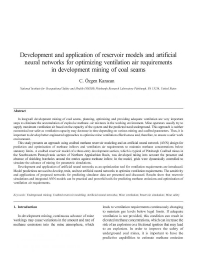 |
In longwall development mining of coal seams, planning, optimizing and providing adequate ventilation are very important steps to eliminate the accumulation of explosive methane-air mixtures in the working environment. Mine operators usually try to supply maximum ventilation air based on the capacity of the system and the predicted need underground. This approach is neither economical nor safer as ventilation capacity may decrease in time depending on various mining and coalbed parameters. Thus, it is important to develop better engineered approaches to optimize mine ventilation effectiveness and, therefore, to ensure a safer work environment. This study presents an approach using coalbed methane reservoir modeling and an artificial neural network (ANN) design for prediction and optimization of methane inflows and ventilation air requirements to maintain methane concentrations below statutory limits. A coalbed reservoir model of a three-entry development section, which is typical of Pittsburgh Coalbed mines in the Southwestern Pennsylvania section of Northern Appalachian Basin, was developed taking into account the presence and absence of shielding boreholes around the entries against methane inflow. In the model, grids were dynamically controlled to simulate the advance of mining for parametric simulations. Development and application of artificial neural networks as an optimization tool for ventilation requirements are introduced. Model predictions are used to develop, train, and test artificial neural networks to optimize ventilation requirements. The sensitivity and applications of proposed networks for predicting simulator data are presented and discussed. Results show that reservoir simulations and integrated ANN models can be practical and powerful tools for predicting methane emissions and optimization of ventilation air requirements.
| Author(s): | Karacan-CÖ |
| Reference: | Int J Coal Geol 2007 Nov; 72(3-4):221-239 |
daaorm (PDF, 1131 KB)
